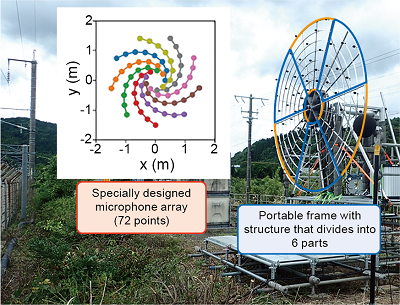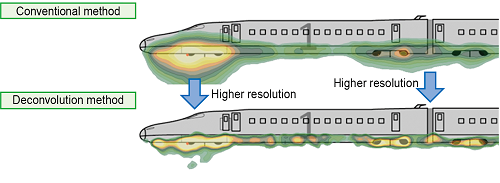19. High-resolution sound source identification method for wayside noise reduction measures
When examining ways to reduce noise along Shinkansen lines, which is increasing as Shinkansen trains continue to get faster, it is necessary to understand the relevant sound sources distributed around vehicles.
For this purpose, we created a portable twodimensional spiral array system with a microphone array specially designed for measuring sound source distribution along railway lines (Fig. 1).
This array system has enough spatial resolution to distinguish sound sources near the wheels of each axle when targeting a bogie.
We also utilized a method of converting data recorded by the system, by analyzing it with a general-purpose signal processing program and then storing it in a database. This enables high-resolution identification of moving sound sources using a deconvolution method to remove sound source “fuzziness” caused by the geometric microphone array.
This is the first attempt of its kind in the railway field in Japan. The sound source identification method is proven to increase the spatial resolution of sound source distribution by a factor of approx. nine (three times higher in the railway line direction and three times higher in the vertical direction) compared to the conventional signal processing method, which utilizes the delay and sum method. At this higher resolution, the sound sources around vehicles can be determined in excellent detail.
For example, sound sources in and around the wheels of each axle of a fast-moving Shinkansen bogie and in the gaps between its vehicles can be clearly discerned (Fig. 2).
The method makes it possible to investigate noise reduction measures for sound sources identified in bogies and pantographs and to demonstrate their effectiveness.


